Determination of Phycocyanin from Space—A Bibliometric Analysis
Abstract
1. Introduction
2. Materials and Methods
2.1. Previous Reviews on Remote Sensing of Phycocyanin
2.2. Data Acquisition
2.3. Methodology
3. Results
3.1. 30 Years of Remote Sensing of Phycocianin
3.2. Decade-by-Decade Analysis
3.2.1. Period I (1991–2000)
3.2.2. Period II (2001–2010)
3.2.3. Period III (2011–2020)
4. Discussion
5. Conclusions
Supplementary Materials
Author Contributions
Funding
Acknowledgments
Conflicts of Interest
Appendix A
| Reference 1 | Journal | Citations | Year |
|---|---|---|---|
| Simis et al. (2007) | Remote Sensing of Environment | 38 | 2007 |
| Simis et al. | Limnology and Oceanography | 35 | 2005 |
| Hunter et al. | Remote Sensing of Environment | 31 | 2010 |
| Ruiz-Verdú et al. | Remote Sensing of Environment | 29 | 2008 |
| Randolph et al. | Remote Sensing of Environment | 29 | 2008 |
| Ogashawara et al. | Remote Sensing | 20 | 2013 |
| Matthews et al. (2010) | Remote Sensing of Environment | 19 | 2010 |
| Mishra et al. | Remote Sensing of Environment | 19 | 2013 |
| Hunter et al. | Environmental Science and Technology | 18 | 2009 |
| Kutser et al. (2006) | Estuarine, Coastal and Shelf Science | 18 | 2006 |
Appendix B
| Cluster ID | Top Label (LSI – LSI, p-value) | Top Label (LLR) |
|---|---|---|
| 0 | handheld spectroradiometer (29.03, 10−4); bloom management purposes (29.03, 10−4); turbid lake (24.84, 10−4); hybrid eof algorithm (24.84, 10−4); nonbloom condition (24.84, 10−4); modis cyanobacteria phycocyanin data (24.84, 10−4); dense coincident surface observation (20.67, 10−4); cyanobacterial total biovolume (20.67, 10−4); satellite reflectance algorithm (20.67, 10−4); temperate reservoir (20.67, 10−4); lake water quality (16.51, 10−4); | cyanobacteria; challenges; mapping cyanotoxin patterns; deep reservoir; drinking-water source; turbid lake; western basin; cyanobacterial total biovolume; evaluation; handheld spectroradiometer | lake erie; western basin; phytoplankton pigment absorption properties; regional example; cyanobacteria bloom waters; deep reservoir; drinking-water source; turbid lake; cyanobacterial total biovolume; evaluation |
| 1 | using genetic algorithm-partial leasts square (12.45, 0.001); potable water source (12.45, 0.001); hyperspectral retrieval (12.45, 0.001); microcystis aeruginosa (8.29, 0.005); eutrophic shallow lake (8.29, 0.005); case study (8.29, 0.005); spatial dynamics (8.29, 0.005); vertical migration (8.29, 0.005) | phycocyanin; modeling; hyperspectral retrieval; potable water sources; using genetic algorithm-partial least squares; suspended particulate matter; phytoplankton colour groups; spectral resolution; effect; sensor | suspended particulate matter; spectral discrimination; phytoplankton colour groups; spectral resolution; effect; sensor; using genetic algorithm-partial least squares; chlorophyll-a; modeling; current review |
| 2 | quasi-analytical algorithm (25.56, 10−4); retrieving absorption coefficient (18.06, 10−4); hyperspectral remote sensing reflectance (18.06, 10−4); multiple phytoplankton pigment (18.06, 10−4); organic matter (14.45, 0.001); cyanobacteria bloom water (12.94, 0.001); tropical eutrophic water (10.92, 0.001); mapping cyanobacterial bloom (10.05, 0.005); lake erie (8.13, 0.005) | quasi-analytical algorithm; parametrization; calibration; tropical eutrophic waters; cyanobacteria; mapping cyanotoxin patterns; challenges; semi-analytical algorithm; cyanobacteria biovolume; phycocyanin | cyanobacteria; challenges; mapping cyanotoxin patterns; using vertical cumulative pigment concentration; deep reservoir; phycocyanin; cyanobacteria biovolume; semi-analytical algorithm; remote estimation; meris sensor |
| 3 | cyanobacterial pigment (17.52, 10−4); theoretical basis (13.35, 0.001); cyanobacterial phycocyanin pigment concentration (13.35, 0.001); practical consideration (13.35, 0.001); eutrophic lake (13.29, 0.001); cell population (9.3, 0.005); using ocm satellite data (9.03, 0.005); freshwater lake (9.03, 0.005) | cyanobacterial pigments; freshwater lake; estimation; using ocm satellite data; cell populations; lake erie; evaluating multiple colour-producing agents; case ii waters; chlorophyll-a; mineral matter | mineral matter; cdom; absorption coefficients; central indiana reservoirs; chlorophyll; determination; cyanobacterial pigments; freshwater lake; estimation; using ocm satellite data |
| 4 | monitoring cyanobacterial bloom (16.35, 10−4); recognising cyanobacterial bloom (8.12, 0.005); modelling study (8.12, 0.005); optical signature (8.12, 0.005) | fluorescence characteristics; salinity gradient; phytoplankton; spectral absorption; different size fractions; baltic sea; recognising cyanobacterial blooms; modelling study; monitoring cyanobacterial blooms; satellite | recognising cyanobacterial blooms; modelling study; optical signature; fluorescence characteristics; salinity gradient; phytoplankton; spectral absorption; different size fractions; baltic sea; monitoring cyanobacterial blooms |
| 5 | china; lake; seasonal-spatial variation; shallow lake; phytoplankton absorption; multidecadal time series; south; satellite-detected accumulations; portugal; pigment c-phycocyanin | evaluation; east china; several lakes; spring bloom formation; remote sensing algorithms; cyanobacterial pigment retrievals; multidecadal time series; south; satellite-detected accumulations; portugal | |
| 6 | cyanobacterial biomass (32.04, 10−4); phycocyanin detection (27.56, 10−4); landsat tm data (27.56, 10−4); phytoplankton pigment composition (23.17, 10−4); cyanobacterial pigment phycocyanin (18.89, 10−4); spectral absorption (14.98, 0.001); different size fraction (14.98, 0.001); fluorescence characteristics (14.98, 0.001); salinity gradient (14.98, 0.001); phytoplankton absorption spectra (14.83, 0.001); inverse modeling approach (14.83, 0.001); phycocyanin pigment (14.74, 0.001); lake erie (10.85, 0.001); lake taihu (10.68, 0.005); baltic sea (9.41, 0.005); mapping cyanobacterial bloom (7.96, 0.005) | cyanobacterial biomass; algorithms; evaluation; phytoplankton absorption spectra; inverse modeling approach; estimating phytoplankton pigment concentrations; fluorescence characteristics; phytoplankton; spectral absorption; baltic sea | fluorescence characteristics; phytoplankton; spectral absorption; baltic sea; salinity gradient; different size fractions; algorithms; cyanobacterial biomass; cyanobacterial pigment phycocyanin; lake erie |
| 7 | cyanobacterial bloom (20.55, 10−4); user need (19.04, 10−4); future development (19.04, 10−4); multidisciplinary remote sensing ocean color sensor (19.04, 10−4); aquatic ecosystem (16.14, 10−4); hyperspectral global mapping satellite mission (16.14, 10−4); measuring freshwater (16.14, 10−4); floating algae index (13.35, 0.001); monitoring level (13.35, 0.001); visual cyanobacteria index (13.35, 0.001); multiscale mapping assessment (10.68, 0.005); cyanobacterial harmful algal bloom (10.68, 0.005); mapping cyanobacterial bloom (10.62, 0.005); lake erie (8.59, 0.005) | waters; semi-analytical algorithm; phycocyanin; remote estimation; deep reservoir; algorithms; modeling; comparative review; new scheme; user needs | new scheme; complex turbid; hyperspectral reflectance; implications; test; inversion algorithms; reconstruction; cyanobacterial harmful algal blooms; multiscale mapping assessment; lake champlain |
| 9 | great lake (15.82, 10−4); using modis (15.82, 10−4); mapping cyanobacterial bloom (14.44, 0.001); drinking-water source (12.43, 0.001); modis observation (12.43, 0.001); cyanobacterial risk (12.43, 0.001); long-term safety evaluation (12.43, 0.001); case ii water (10.33, 0.005); evaluating multiple colour-producing agent (10.33, 0.005); meris satellite data (8.23, 0.005); using quickbird (8.23, 0.005); missisquoi bay (8.23, 0.005) | mapping cyanobacterial blooms; meris satellite data; using quickbird; current review; near-coastal transitional waters; empirical procedures; lake erie; evaluating multiple colour-producing agents; case ii waters; using modis | drinking-water source; cyanobacterial risks; implications; modis observations; long-term safety evaluation; eutrophic lake; complex waters; cyanobacteria abundance; ocean colour estimation; inherent optical properties |
| 11 | active pigment (22.35, 10−4); turbid productive water (22.35, 10−4); mesotrophic reservoir (13.61, 0.001); predicting phycocyanin concentration (9.45, 0.005); novel algorithm (9.45, 0.005); | cyanobacteria; predicting phycocyanin concentrations; novel algorithm; proximal hyperspectral remote sensing approach; mesotrophic reservoir; phycocyanin; turbid productive water; chlorophyll; chlorophyll-a | phycocyanin; turbid productive water; chlorophyll; proximal hyperspectral remote sensing approach; predicting phycocyanin concentrations; chlorophyll-a; mesotrophic reservoir; cyanobacteria; novel algorithm |
References
- Bartram, J.; Carmichael, W.W.; Chorus, I.; Jones, G.; Skulberg, O.M. Introduction. In Toxic Cyanobacteria in Water: A Guide to Their Public Health Consequences, Monitoring and Management, 1st ed.; Chorus, I., Bartram, J., Eds.; UNESCO/WHO/UNEP: London, UK, 1999; Chapter 1; pp. 12–24. [Google Scholar]
- Codd, G.A.; Lindsay, J.; Young, F.M.; Morrison, L.F.; Metcalf, J.S. Harmful Cyanobacteria. In Harmful Cyanobacteria, 1st ed.; Huisman, J., Matthijs, H.C.P., Visser, P.M., Eds.; Springer: Dordrecht, The Netherlands, 2005; Chapter 1; pp. 1–23. [Google Scholar]
- Sivonen, K.; Jones, G. Cyanobacterial Toxins. In Toxic Cyanobacteria in Water: A Guide to Their Public Health Consequences, Monitoring and Management, 1st ed.; Chorus, I., Bartram, J., Eds.; UNESCO/WHO/UNEP: London, UK, 1999; Chapter 3; pp. 55–124. [Google Scholar]
- Carmichael, W.W. Health effects of toxin producing cyanobacteria: The cyanoHABs. Hum. Ecol. Risk Assess. 2001, 7, 1393–1407. [Google Scholar] [CrossRef]
- Simis, S.G.H.; Peters, S.W.M.; Gons, H.J. Remote sensing of the cyanobacterial pigment phycocyanin in turbid inland water. Limnol. Oceanogr. 2005, 50, 237–245. [Google Scholar] [CrossRef]
- Li, L.; Sengpiel, R.E.; Pascual, D.L.; Tedesco, L.D.; Wilson, J.S.; Soyeux, E. Using hyperspectral remote sensing to estimate chlorophyll-a and phycocyanin in a mesotrophic reservoir. Int. J. Remote Sens. 2010, 31, 4147–4162. [Google Scholar] [CrossRef]
- Le, C.; Li, Y.; Zha, Y.; Wang, Q.; Zhang, H.; Yin, B. Remote sensing of phycocyanin pigment in highly turbid inland waters in Lake Taihu, China. Int. J. Remote Sens. 2011, 32, 8253–8269. [Google Scholar] [CrossRef]
- Matthews, M.W.; Odermatt, D. Improved algorithm for routine monitoring of cyanobacteria and eutrophication in inland and near-coastal waters. Remote Sens. Environ. 2015, 156, 374–382. [Google Scholar] [CrossRef]
- Reynolds, C.S. Cyanobacterial Water-Blooms. In Advances in Botanical Research; Callow, J.A., Ed.; Academic Press Inc.: London, UK, 1987; Volume 13, pp. 67–143. [Google Scholar] [CrossRef]
- Hyenstrand, P.; Blomqvist, P.; Pettersson, A. Factors determining cyanobacterial success in aquatic systems: A literature review. Arch. Hydrobiol. 1998, 51, 41–62. [Google Scholar]
- Paerl, H.W. Marine Plankton. In Ecology of Cyanobacteria II: Their Diversity in Space and Time; Whitton, B.A., Ed.; Springer: Dordrecht, The Netherlands, 2012; pp. 127–153. [Google Scholar]
- Duan, H.; Ma, R.; Xu, J.; Zhang, Y.; Zhang, B. Comparison of different semi-empirical algorithms to estimate chlorophyll-a concentration in inland lake water. Environ. Monit. Assess. 2010, 170, 231–244. [Google Scholar] [CrossRef]
- Gons, H.J. Optical Teledetection of Chlorophyll a in Turbid Inland Waters. Environ. Sci. Technol. 1999, 33, 1127–1132. [Google Scholar] [CrossRef]
- Hadijimitsis, D.G.; Clayton, C. Assessment of temporal variations of water quality in inland water bodies using atmospheric corrected satellite remotely sensed image data. Environ. Monit. Assess. 2009, 159, 281–292. [Google Scholar] [CrossRef]
- Reinart, A.; Kutser, T. Comparison of different satellite sensors in detecting cyanobacterial bloom events in the Baltic Sea. Remote Sens. Environ. 2006, 102, 74–85. [Google Scholar] [CrossRef]
- Hunter, P.D.; Tyler, A.N.; Gilvear, D.J.; Willby, N.J. Using remote sensing to aid the assessment of human health risks from blooms of potentially toxic cyanobacteria. Environ. Sci. Technol. 2009, 43, 2627–2633. [Google Scholar] [CrossRef] [PubMed]
- Vincent, R.K.; Qin, X.; McKay, R.M.L.; Miner, J.; CzajkowskI, K.; Savino, J.; Bridgeman, T. Phycocyanin detection from LANDSAT TM data for mapping cyanobacterial blooms in Lake Erie. Remote Sens. Environ. 2004, 89, 381–392. [Google Scholar] [CrossRef]
- Mishra, S.; Mishra, D.R.; Schluchter, W.M. A Novel algorithm for predicting phycocyanin concentrations in cyanobacteria: A proximal hyperspectral remote sensing approach. Remote Sens. 2009, 1, 758–775. [Google Scholar] [CrossRef]
- Ogashawara, I.; Mishra, D.; Mishra, S.; Curtarelli, M.; Stech, J. A Performance Review of Reflectance Based Algorithms for Predicting Phycocyanin Concentrations in Inland Waters. Remote Sens. 2013, 5, 4774–4798. [Google Scholar] [CrossRef]
- Stumpf, R.; Dupuy, D. Experimental Lake Erie Harmful Algal Bloom Bulletin—Bulletin 28/2016; NOAA: Washington, DC, USA, 2016.
- Cyanobacteria Assessment Network (CyAN). Available online: https://www.epa.gov/water-research/cyanobacteria-assessment-network-cyan#satellitealgorithms (accessed on 24 November 2017).
- IIWQ Water Quality Portal. Available online: http://www.worldwaterquality.org/ (accessed on 16 January 2020).
- Ruiz-Verdú, A.; Simis, S.G.H.; de Hoyos, C.; Gons, H.J.; Peña-Martínez, R. An evaluation of algorithms for the remote sensing of cyanobacterial biomass. Remote Sens. Environ. 2008, 112, 3996–4008. [Google Scholar] [CrossRef]
- Beck, R.; Xu, M.; Zhan, S.; Liu, H.; Johansen, R.; Tong, S.; Yang, B.; Shu, S.; Wu, Q.; Wang, S.; et al. Comparison of Satellite Reflectance Algorithms for Estimating Phycocyanin Values and Cyanobacterial Total Biovolume in a Temperate Reservoir Using Coincident Hyperspectral Aircraft Imagery and Dense Coincident Surface Observations. Remote Sens. 2017, 9, 538. [Google Scholar] [CrossRef]
- Yan, Y.; Bao, Z.; Shao, J. Phycocyanin concentration retrieval in inland waters: A comparative review of the remote sensing techniques and algorithms. J. Great Lakes Res. 2018, 44, 748–755. [Google Scholar] [CrossRef]
- Riddick, C.A.L.; Hunter, P.D.; Domínguez-Gómez, J.A.; Martinez-Vicente, V.; Présing, M.; Horváth, H.; Kovács, A.W.; Vörös, L.; Zsigmond, E.; Tyler, A.N. Optimal Cyanobacterial Pigment Retrieval from Ocean Colour Sensors in a Highly Turbid, Optically Complex Lake. Remote Sens. 2019, 11, 1613. [Google Scholar] [CrossRef]
- Shi, K.; Zhang, Y.; Qin, B.; Zhou, B. Remote sensing of cyanobacterial blooms in inland waters: Present knowledge and future challenges. Sci. Bull. 2019, 64, 1540–1556. [Google Scholar] [CrossRef]
- Schalles, J.F.; Yacobi, Y.Z. Remote detection and seasonal patterns of phycocyanin, carotenoid and chlorophyll pigments in eutrophic waters. Ergeb. Limnol. 2000, 55, 153–168. [Google Scholar]
- Mishra, S.; Mishra, D.R.; Lee, Z.; Tucker, C.S. Quantifying cyanobacterial phycocyanin concentration in turbid productive waters: A quasi-analytical approach. Remote Sens. Environ. 2013, 133, 141–151. [Google Scholar] [CrossRef]
- Li, L.; Li, L.; Song, K. Remote sensing of freshwater cyanobacteria: An extended IOP Inversion Model of Inland Waters (IIMIW) for partitioning absorption coefficient and estimating phycocyanin. Remote Sens. Environ. 2015, 157, 9–23. [Google Scholar] [CrossRef]
- Dekker, A.G. Detection of Optical Water Quality Parameters for Eutrophic Waters by High Resolution Remote Sensing. Ph.D. Thesis, Proefschrift Vrije Universiteit (Free University), Amsterdam, The Netherlands, 1993. [Google Scholar]
- Hunter, P.D.; Tyler, A.N.; Carvalho, L.; Codd, G.A.; Maberly, S.C. Hyperspectral remote sensing of cyanobacterial pigments as indicators for cell populations and toxins in eutrophic lakes. Remote Sens. Environ. 2010, 114, 2705–2718. [Google Scholar] [CrossRef]
- Mishra, S. Remote Sensing of Cyanobacteria in Turbid Productive Waters. Ph.D. Thesis, Mississippi State University, Starkville, MS, USA, 2012. [Google Scholar]
- Mishra, S.; Mishra, D.R. A novel remote sensing algorithm to quantify phycocyanin in cyanobacterial algal blooms. Environ. Res. Lett. 2014, 9, 114003. [Google Scholar] [CrossRef]
- Stumpf, R.P.; Davis, T.W.; Wynne, T.T.; Graham, J.L.; Loftin, K.A.; Johengen, T.H.; Gossiaux, D.; Palladino, D.; Burtner, A. Challenges for mapping cyanotoxin patterns from remote sensing of cyanobacteria. Harmful Algae 2016, 54, 160–173. [Google Scholar] [CrossRef] [PubMed]
- Wynne, T.T.; Stumpf, R.P.; Tomlinson, M.C.; Warner, R.A.; Tester, P.A.; Dyble, J.; Fahnenstiel, G.L. Relating spectral shape to cyanobacterial blooms in the Laurentian Great Lakes. Int. J. Remote Sens. 2008, 29, 3665–3672. [Google Scholar] [CrossRef]
- Dash, P.; Walker, N.D.; Mishra, D.R.; Hu, C.; Pinckney, J.L.; D’Sa, E.J. Estimation of cyanobacterial pigments in a freshwater lake using OCM satellite data. Remote Sens. Environ. 2011, 115, 3409–3423. [Google Scholar] [CrossRef]
- Li, L.; Li, L.; Shi, K.; Li, Z.; Song, K. A semi-analytical algorithm for remote estimation of phycocyanin in inland waters. Sci. Total Environ. 2012, 435, 141–150. [Google Scholar] [CrossRef]
- Qi, L.; Hu, C.; Duan, H.; Cannizzaro, J.; Ma, R. A novel MERIS algorithm to derive cyanobacterial phycocyanin pigment concentrations in a eutrophic lake: Theoretical basis and practical considerations. Remote Sens. Environ. 2014, 154, 298–317. [Google Scholar] [CrossRef]
- Liu, G.; Simis, S.G.H.; Li, L.; Wang, Q.; Li, Y.; Song, K.; Lyu, H.; Zheng, Z.; Shi, K. A Four-Band Semi-Analytical Model for Estimating Phycocyanin in Inland Waters From Simulated MERIS and OLCI Data. IEEE Trans. Geosci. Remote Sens. 2018, 56, 1374–1385. [Google Scholar] [CrossRef]
- Hunter, P.; Tyler, A.; Presing, M.; Kovacs, A.; Preston, T. Spectral discrimination of phytoplankton colour groups: The effect of suspended particulate matter and sensor spectral resolution. Remote Sens. Environ. 2008, 112, 1527–1544. [Google Scholar] [CrossRef]
- Randolph, K.; Wilson, J.; Tedesco, L.; Li, L.; Pascual, D.L.; Soyeux, E. Hyperspectral remote sensing of cyanobacteria in turbid productive water using optically active pigments, chlorophyll a and phycocyanin. Remote Sens. Environ. 2008, 112, 4009–4019. [Google Scholar] [CrossRef]
- Duan, H.; Ma, R.; Hu, C. Evaluation of remote sensing algorithms for cyanobacterial pigment retrievals during spring bloom formation in several lakes of East China. Remote Sens. Environ. 2012, 126, 126–135. [Google Scholar] [CrossRef]
- Wheeler, S.M.; Morrissey, L.A.; Levine, S.N.; Livingston, G.P.; Vincent, W.F. Mapping cyanobacterial blooms in Lake Champlain’s Missisquoi Bay using QuickBird and MERIS satellite data. J. Great Lakes Res. 2012, 38, 68–75. [Google Scholar] [CrossRef]
- Sun, D.; Li, Y.; Wang, Q.; Gao, J.; Le, C.; Huang, C.; Gong, S. Hyperspectral Remote Sensing of the Pigment C-Phycocyanin in Turbid Inland Waters, Based on Optical Classification. IEEE Trans. Geosci. Remote Sens. 2013, 51, 3871–3884. [Google Scholar] [CrossRef]
- Wozniak, M.; Bradtke, K.M.; Darecki, M.; Krężel, A. Empirical model for phycocyanin concentration estimation as an indicator of cyanobacterial bloom in the optically complex coastal waters of the Baltic Sea. Remote Sens. 2016, 8, 212. [Google Scholar] [CrossRef]
- Chen, C. Searching for intellectual turning points: Progressive knowledge domain visualization. Proc. Natl. Acad. Sci. USA 2004, 101, 5303–5310. [Google Scholar] [CrossRef]
- Chen, C. Citespace ii: Detecting and visualizing emerging trends and transient patterns in scientific literature. J. Am. Soc. Inf. Sci. Technol. 2006, 57, 359–377. [Google Scholar] [CrossRef]
- Small, H. Co-citation in the scientific literature: A new measure of the relationship between two documents. J. Am. Soc. Inf. Sci. 1973, 24, 265–269. [Google Scholar] [CrossRef]
- Ogashawara, I.; Alcântara, E.H.; Stech, J.L.; Tundisi, J.G. Cyanobacterial Detection in Guarapiranga Reservoir (São Paulo State, Brazil) From Landsat TM and ETM + Images. Rev. Ambiente. Água 2014, 9, 224–238. [Google Scholar] [CrossRef]
- Oyama, Y.; Matsushita, B.; Fukushima, T. Distinguishing surface cyanobacterial blooms and aquatic macrophytes using landsat/TM and ETM + shortwave infrared bands. Remote Sens. Environ. 2015, 157, 35–47. [Google Scholar] [CrossRef]
- Francis, G. Poisonous Australian Lake. Nature 1878, 18, 11–12. [Google Scholar] [CrossRef]
- Chapra, S.C.; Boehlert, B.; Fant, C.; Bierman, V.J., Jr.; Henderson, J.; Mills, D.; Mas, D.M.L.; Rennels, L.; Jantarasami, L.; Martinich, J.; et al. Climate Change Impacts on Harmful Algal Blooms in U.S. Freshwaters: A Screening-Level Assessment. Environ. Sci. Technol. 2017, 51, 8933–8943. [Google Scholar] [CrossRef] [PubMed]
- Greb, S.; Dekker, A.; Binding, C. (Eds.) Earth Observations in Support of Global Water Quality Monitoring; IOCCG Report Series, No. 17; International Ocean Colour Coordinating Group: Dartmouth, NS, Canada, 2018. [Google Scholar]
- Paerl, H.W.; Huisman, J. Blooms like it hot. Science 2008, 320, 57–58. [Google Scholar] [CrossRef]
- Matisoff, G.; Kaltenberg, E.M.; Steely, R.L.; Hummel, S.K.; Seo, J.; Gibbons, K.J.; Bridgeman, T.B.; Seo, Y.; Behbahani, M.; James, W.F.; et al. Internal loading of phosphorus in western Lake Erie. J. Great Lakes Res. 2016, 42, 775–788. [Google Scholar] [CrossRef]
- Ashton, P.J. Seasonality in Southern Hemisphere freshwater phytoplankton assemblages. Hydrobiologia 1985, 125, 179–190. [Google Scholar] [CrossRef]
- Moses, W.J.; Sterckx, S.; Montes, L.; Keukelaere, L.D.; Knaeps, E. Atmospheric correction for inland waters. In Bio-Optical Modeling and Remote Sensing of Inland Waters, 1st ed.; Mishra, D.R., Ogashawara, I., Gitelson, A.A., Eds.; Elsevier: New York, NY, USA, 2017; Chapter 3; pp. 69–100. [Google Scholar]
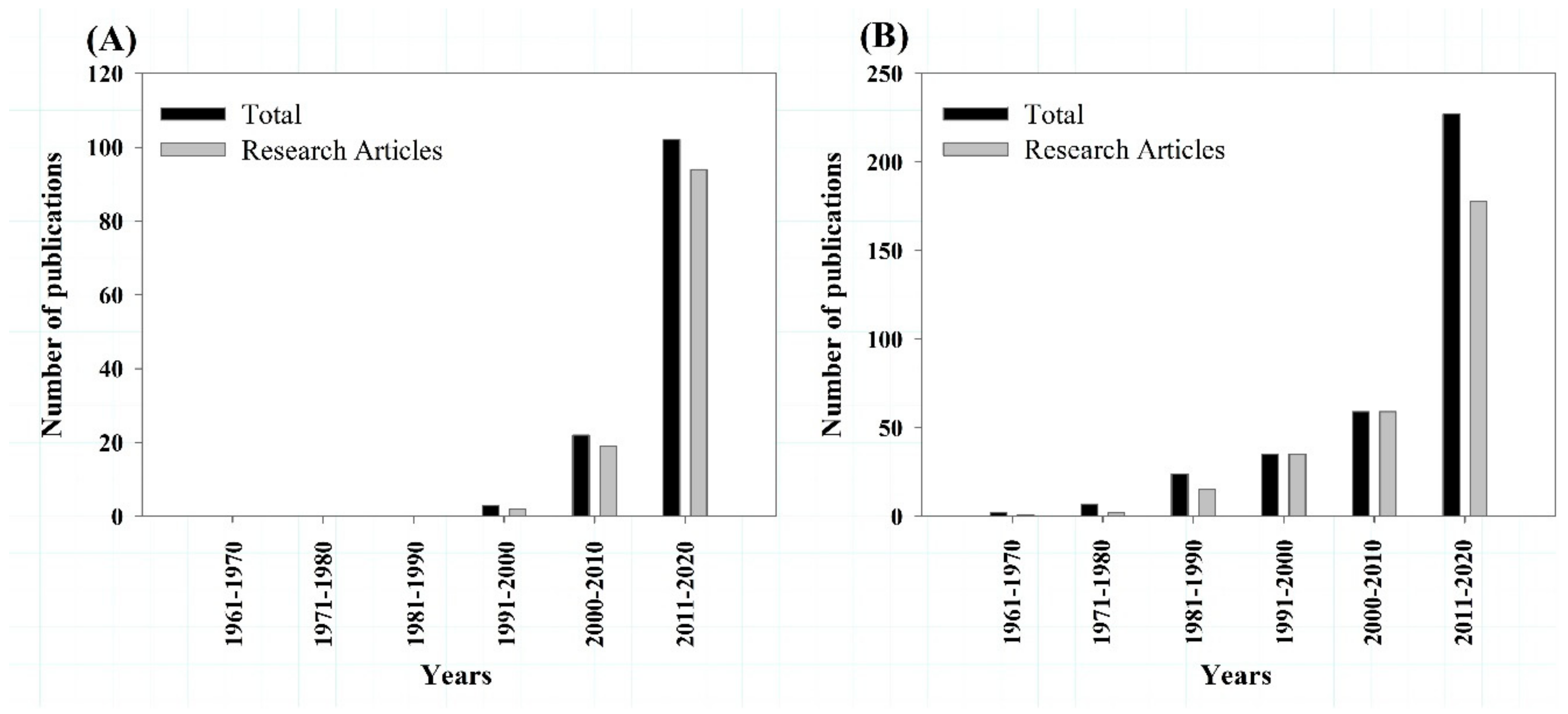
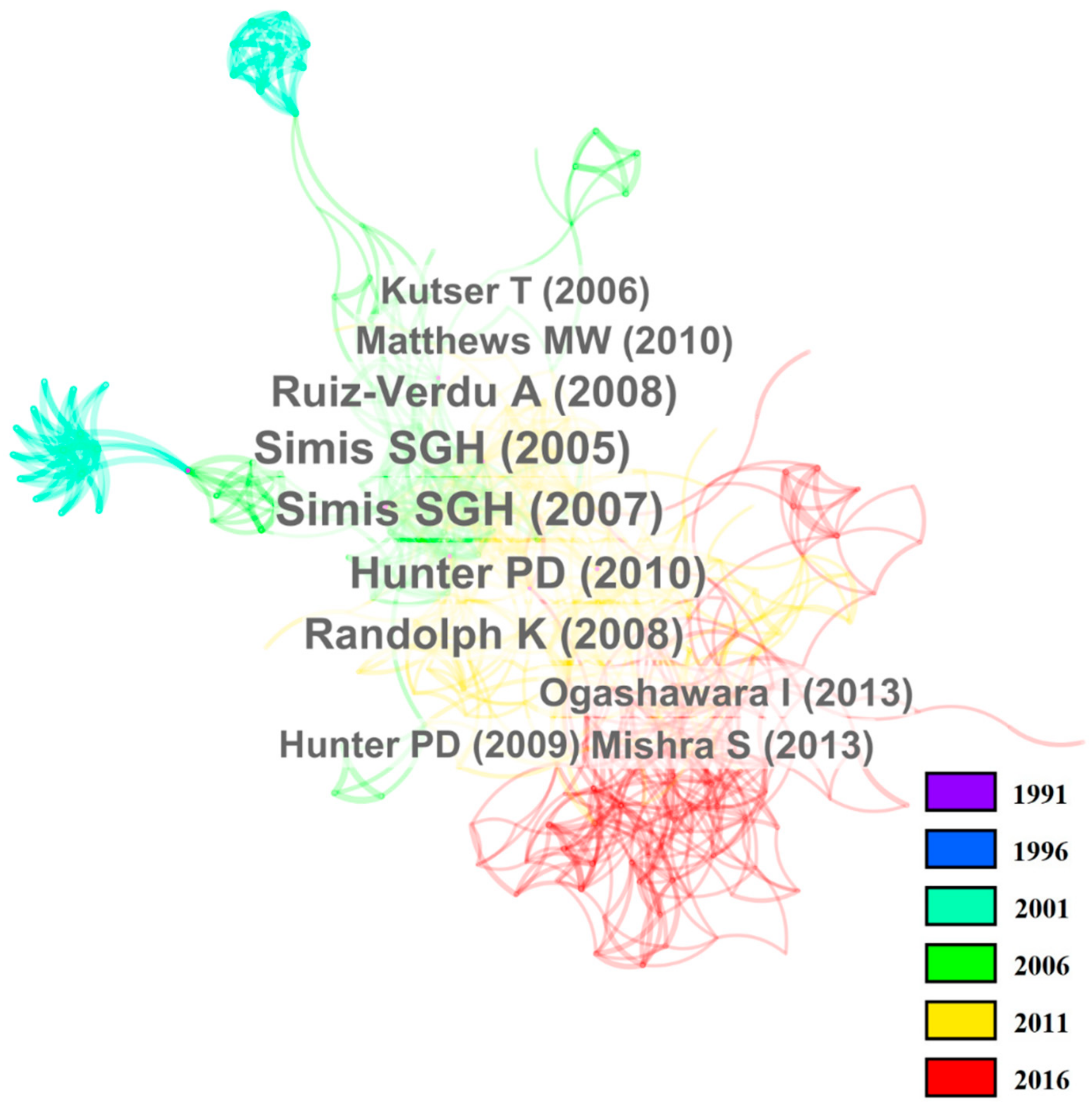
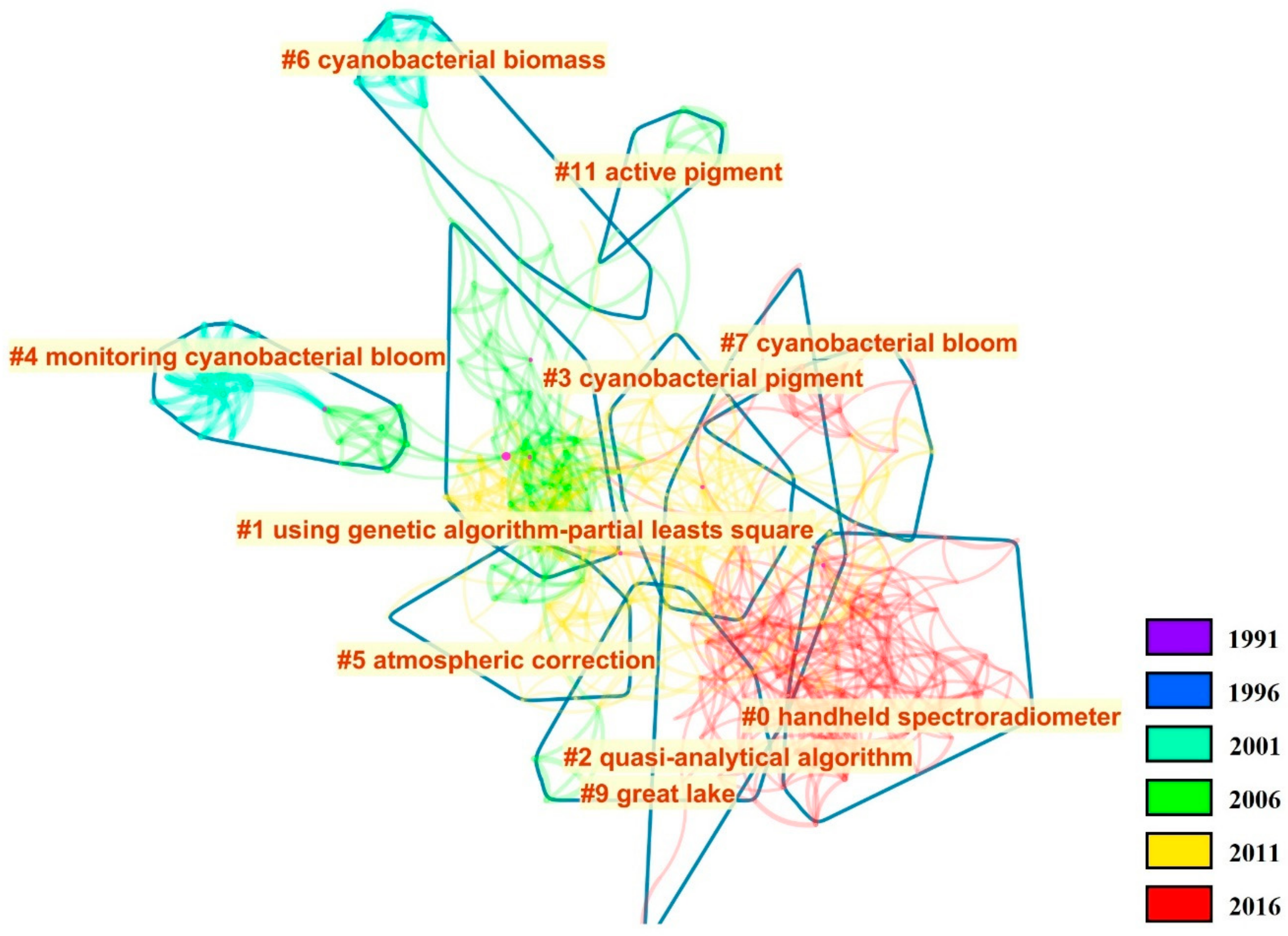
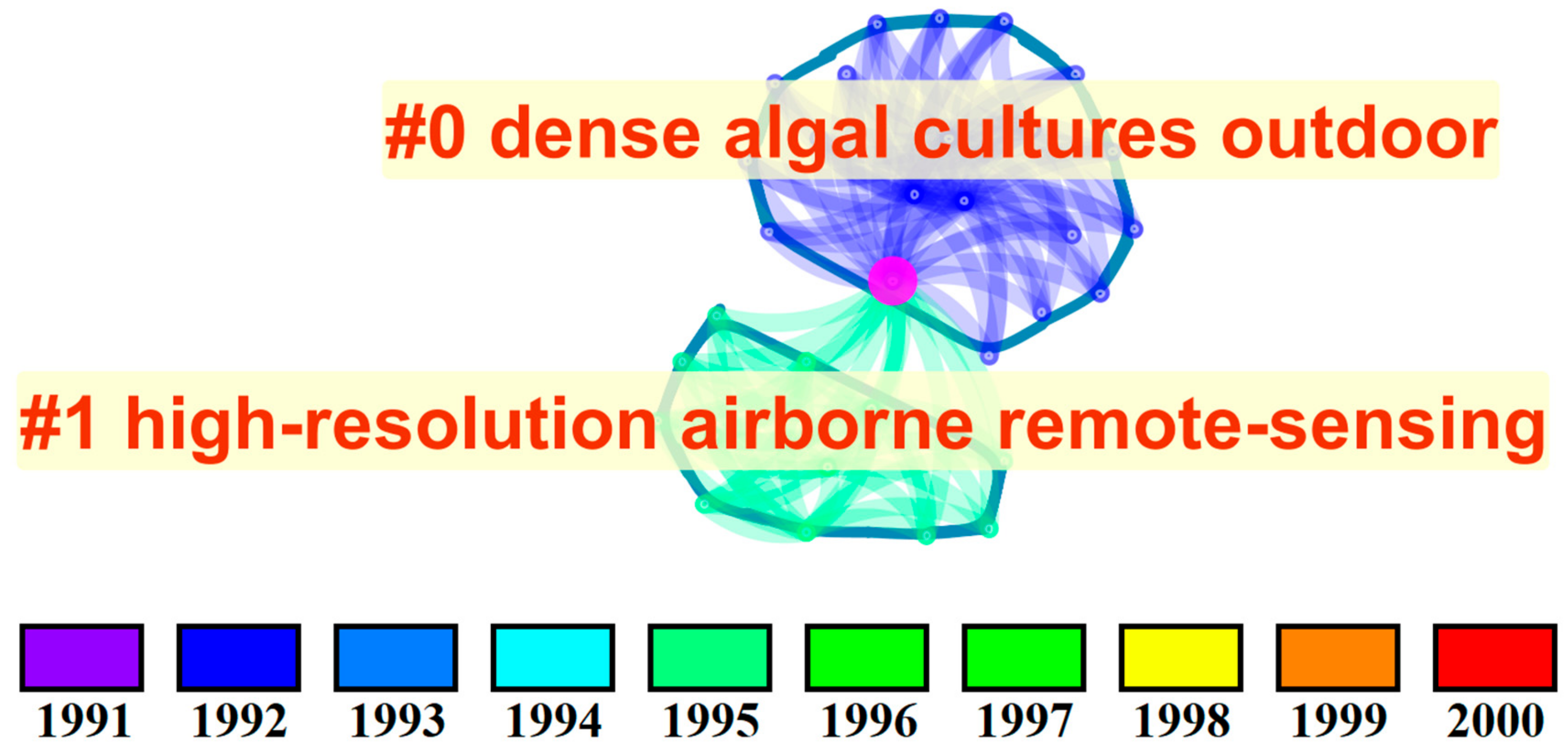
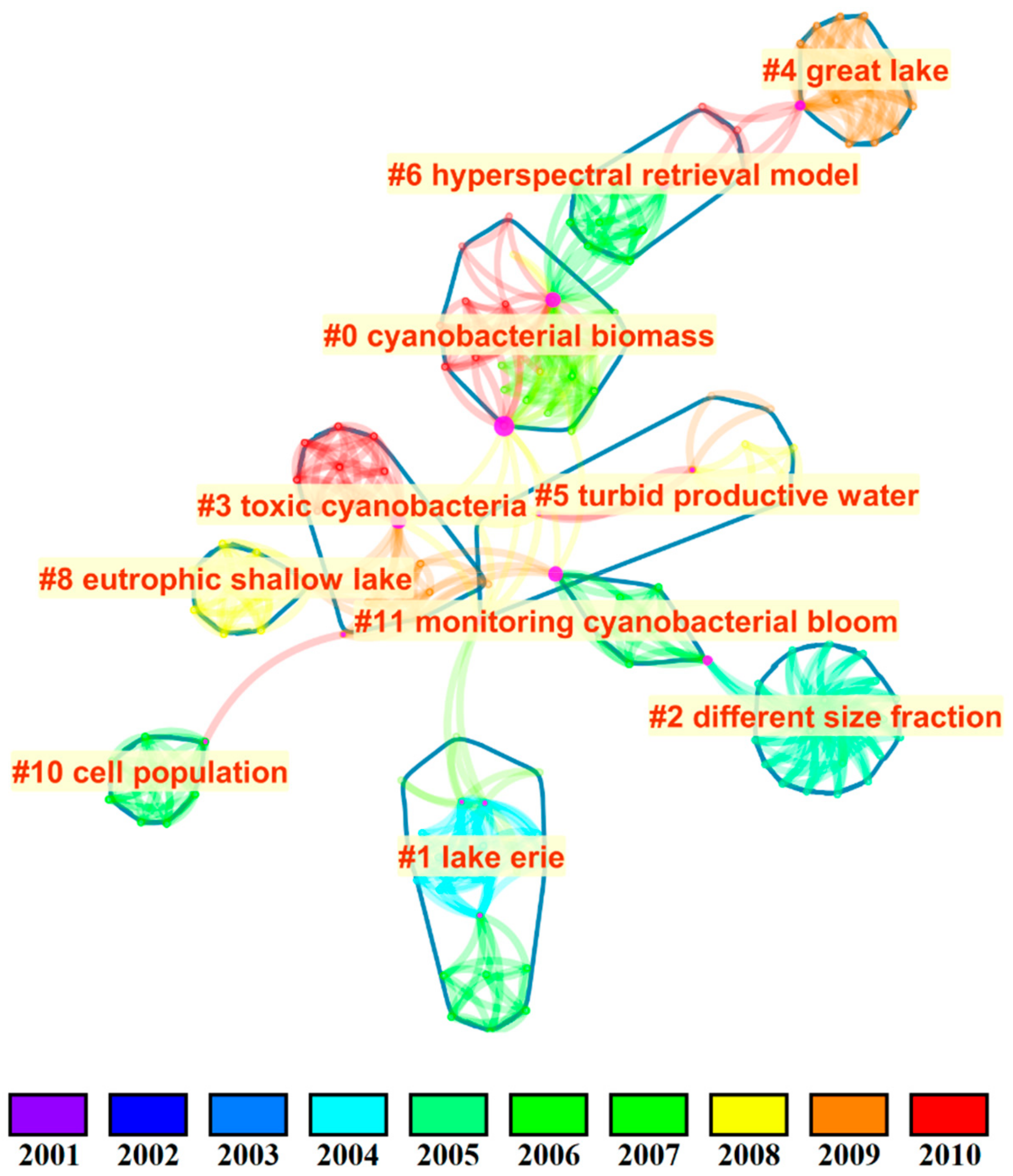
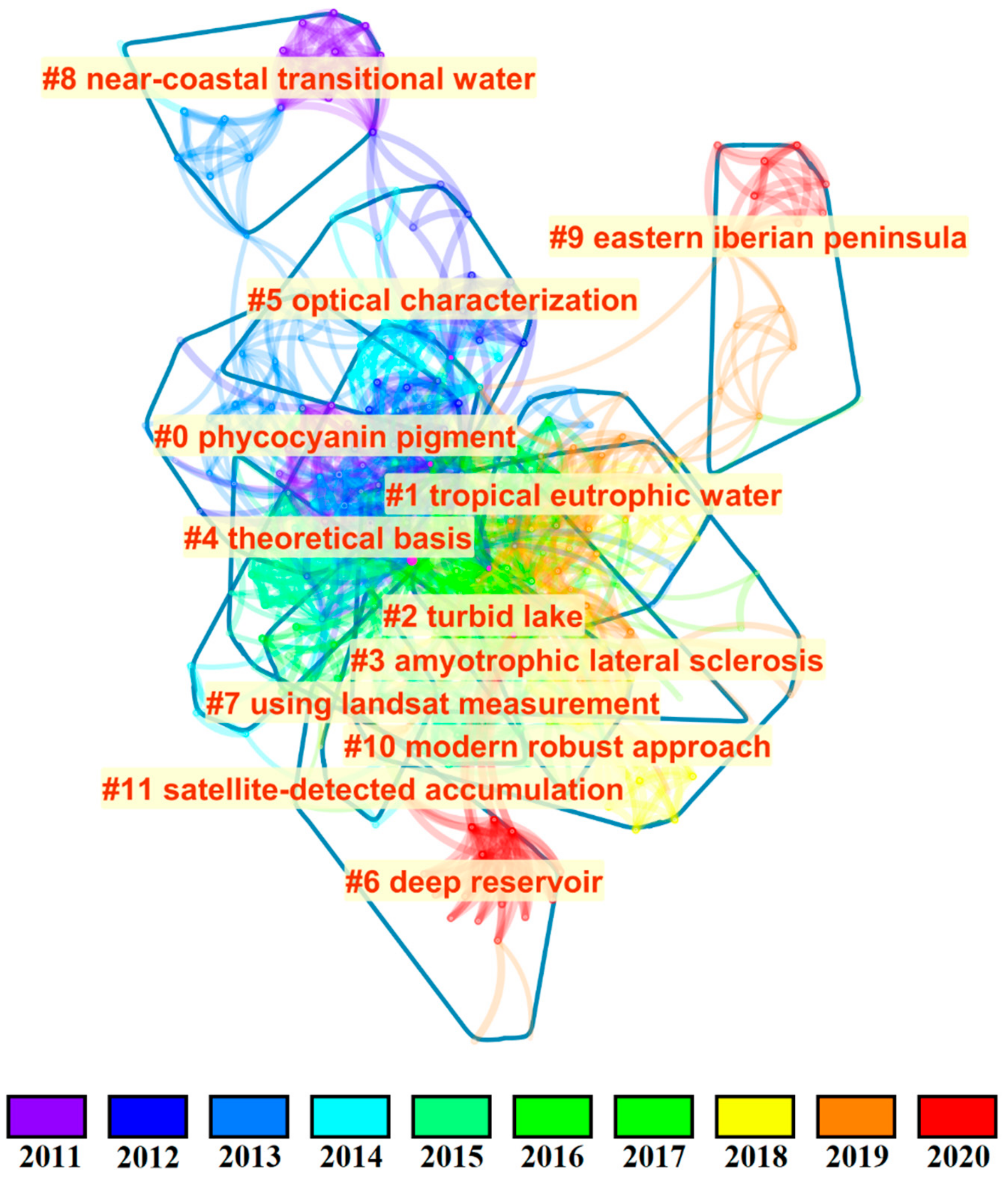
| Study 1 | Study Sites | Reviewed Algorithms 2 |
|---|---|---|
| Ruiz-Verdu et al. | Spanish and Dutch Lakes and Reservoirs | DE93, SC00, SI05 |
| Ogashawara et al. | Funil Hydroelectric Reservoir (Brazil) and Catfish Ponds (USA) | DE93, SC00, SI05, MI09, HU10, MI12 |
| Beck et al. | Harsha Lake (USA) | SC00, SI05, HU10, MI12, MI14, ST16 |
| Yan et al. | - | DE93, SC00, SI05, WY08, MI09, HU10, DA11, LI12, MI13, QI14, MI14 |
| Riddick et al. | Global Lakes (LIMNADES dataset) | DE93, SC00, SI05, HU10, MI13, QI14, LI15, LI18 |
| Shi et al. | - | SC00, VI04, SI05, HU08, RA08, RU08, HU10, DA11, DU12, LI12, WH12, MI13, MI14, QI14, SU15, WO16 |
| Cluster ID | Size | Main Label (LSI) | Main Label (LLR) | Mean (Cited Year) |
|---|---|---|---|---|
| 4 | 21 | Fluorescence characteristics | Monitoring Cyanobacteria Bloom (p-value = 10−4) | 1999 |
| 6 | 17 | Cyanobacterial Biomass | Cyanobacterial Biomass (p-value = 10−4) | 2001 |
| 11 | 7 | Cyanobacteria | Active Pigment (p-value = 10−4) | 2004 |
| 1 | 47 | Phycocyanin | Using genetic algorithm-partial least square (p-value = 10−3) | 2006 |
| 5 | 20 | China | Atmospheric Correction (p-value = 10−4) | 2007 |
| 3 | 30 | Cyanobacterial pigments | Cyanobacterial pigments (p-value = 10−4) | 2008 |
| 9 | 12 | Mapping cyanobacteria bloom | Great Lake (p-value = 10−4) | 2009 |
| 7 | 16 | Waters | Cyanobacteria Bloom (p-value = 10−4) | 2012 |
| 0 | 55 | Cyanobacteria | Handheld spectroradiometer (p-value = 10−4) | 2013 |
| 2 | 36 | Quasi-analytical algorithms | Quasi-analytical algorithms (p-value = 10−4) | 2013 |
| Cluster ID | Size | Main Label (LSI) | Main Label (LLR) | Mean (Cited Year) |
|---|---|---|---|---|
| 0 | 20 | High resolution airborne remote sensing | Optical properties of dense algal cultures (p-value = 0.5) | 1986 |
| 1 | 12 | Optical properties of dense algal cultures | High resolution airborne remote sensing (p-value = 0.5) | 1992 |
| Cluster ID | Size | Main Label (LSI) | Main Label (LLR) | Mean (Cited Year) |
|---|---|---|---|---|
| 2 | 20 | Spectral absorption and fluorescence characteristics | Different size fraction (p-value = 0.5) | 1999 |
| 1 | 22 | Landsat TM data | Lake Erie (p-value = 0.005) | 2000 |
| 11 | 7 | Fluorescence characteristics | Monitoring cyanobacterial bloom (p-value = 0.05) | 2001 |
| 6 | 11 | China | Hyperspectral retrieval model (p-value = 0.05) | 2002 |
| 10 | 8 | Cyanobacterial pigments | Cell population (p-value = 0.1) | 2003 |
| 8 | 9 | Spatial dynamics of vertical migration | Eutrophic shallow lake (p-value = 0.05) | 2003 |
| 0 | 24 | Cyanobacteria biomass | Cyanobacteria biomass (p-value = 0.005) | 2004 |
| 5 | 11 | Phycocyanin | Turbid productive waters (p-value = 0.001) | 2004 |
| 3 | 16 | Cyanobacteria pigments | Toxic cyanobacteria (p-value = 0.05) | 2005 |
| 4 | 14 | Phytoplankton absorption | Great Lake (p-value = 0.05) | 2005 |
| Cluster ID | Size | Main Label (LSI) | Main Label (LLR) | Mean (Cited Year) |
|---|---|---|---|---|
| 8 | 18 | Mineral matter characteristics | Near-coastal transitional water (p-value = 0.001) | 2006 |
| 0 | 48 | Modeling | Phycocyanin pigment (p-value = 10−4) | 2007 |
| 5 | 22 | Case 2 | Optical characterization (p-value = 10−4) | 2008 |
| 11 | 7 | Phycocyanin | Satellite-detected accumulation (p-value = 10−4) | 2010 |
| 7 | 19 | Waters | Using Landsat measurement (p-value = 10−4) | 2010 |
| 4 | 29 | New scheme | Theoretical basis (p-value = 0.01) | 2010 |
| 10 | 14 | Semi-analytical algorithm | Modern robust approach (p-value = 10−4) | 2012 |
| 1 | 41 | Chlorophyll-a prediction algorithms | Tropical eutrophic water (p-value = 10−4) | 2012 |
| 9 | 15 | Cyanobacterial total biovolume | Eastern Iberian Peninsula (p-value = 10−4) | 2013 |
| 3 | 30 | Lake Erie | Risk factor (p-value = 10−4) | 2013 |
| 2 | 36 | Drinking water source | Turbid lake (p-value = 10−4) | 2013 |
| 6 | 20 | Cyanobacterial Blooms | Deep reservoir (p-value = 10−4) | 2015 |
© 2020 by the author. Licensee MDPI, Basel, Switzerland. This article is an open access article distributed under the terms and conditions of the Creative Commons Attribution (CC BY) license (http://creativecommons.org/licenses/by/4.0/).
Share and Cite
Ogashawara, I. Determination of Phycocyanin from Space—A Bibliometric Analysis. Remote Sens. 2020, 12, 567. https://doi.org/10.3390/rs12030567
Ogashawara I. Determination of Phycocyanin from Space—A Bibliometric Analysis. Remote Sensing. 2020; 12(3):567. https://doi.org/10.3390/rs12030567
Chicago/Turabian StyleOgashawara, Igor. 2020. "Determination of Phycocyanin from Space—A Bibliometric Analysis" Remote Sensing 12, no. 3: 567. https://doi.org/10.3390/rs12030567
APA StyleOgashawara, I. (2020). Determination of Phycocyanin from Space—A Bibliometric Analysis. Remote Sensing, 12(3), 567. https://doi.org/10.3390/rs12030567






